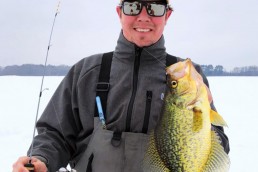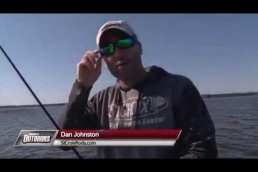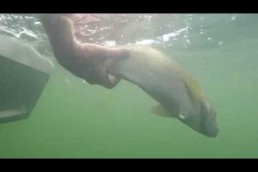Mille Lacs Lake Ice Fishing Adventure
SHARE THIS POST
In the Midwest, as the warm summer months give way to the cold north winds of fall, the land transforms into a new type of playground for outdoor enthusiasts. Long fishing rods get stored away, and the short fishing rods get new lines, leaders and swivels in anticipation of the ice fishing season.
Minnesota’s largest lake, Mille Lacs, is a fantastic location for ice fishing adventure. Mille Lacs offers 132,000 acres of mudflats, rocky reefs, sand and weed flats to pursue monster fish. For most, walleyes are the prime quarry. Ice anglers, however, can also chase giant northern pike, crappies, sunfish and perch. Mille Lacs truly is a multi-species fisher person’s paradise, offering the chance to make memories with every hookset!
As the first layers of ice cover the lake, walleyes can be found in many different locations. There’s an early-season bite right out from shore, on the sand breaks and rock reefs. Walleyes hang around these areas because baitfish are nearby. And when the sunlight begins to fade, the walleyes turn into feeding machines. This bite typically occurs from first ice through January 1, but is also dependent on snow cover and when the ice forms on the lake.
Targeting these near-shore fish is relatively simple. It is always best to cover various depths, because the fish will lock into a specific zone; if you are outside that area, you will have far less action. Some anglers may choose to set the fish house in the mid-depth range, between 13 to 18 feet, and then set tip-ups along the shallow break and the deep break. This way, “base camp” is centrally located, and the tip-ups will be covering from 6 to 10 feet of water, all the way down to 30 feet, depending on the area you are fishing.
The best choice is to be actively jigging with your favorite glow lure, and then have the set-lines with big lively shiners set in surrounding holes. Spreading out and covering water is undoubtedly a good way to get more hooksets.
As the season progresses, the shoreline bite starts to slow down as the baitfish spread back out into the basins and hold out on the mudflats. The vast mudflats of Mille Lacs offer the mobile ice fisherman a chance to drill on spots that have not been touched since summertime. Find a sharp break, and begin drilling the edge in 22 to 30-plus feet of water. Then go back and fish each hole for a short time; if you have no biters, keep moving until you locate an active school of fish.
If it is your first time venturing out onto Mille Lacs lake, and you choose to go out to the mudflats, please go through a resort and follow their plowed ice roads. Mille Lacs is an excellent playground, but if you do not understand pressure ridges and what “bad ice” looks like, you may find yourself in a dangerous or deadly situation very quickly. Ice conditions out on the mud can change by the hour, and sometimes require a new route to get home.
If you are targeting walleyes, always check the regulations before heading out. At the time of writing, beginning on December 1, anglers are allowed to target walleyes, and harvest one fish between 21 and 23 inches, or over 28 inches. All fish less than 21 inches, or greater than 23 inches, must be immediately released, except that one over 28 inches is allowed in possession (dnr.state.mn.us).
Are you enjoying this post?
You can be among the first to get the latest info on where to go, what to use and how to use it!
If you are in the mood to target some of the large, slimy predators that roam the waters of Mille Lacs lake, targeting northern pike can be an excellent thrill! These giants can be found patrolling the weed beds located in various areas of the lake. The best weed beds to target are those that have remaining stocks of cabbage, and that still retain some green color. These weeds attract baitfish, and the predators are not far away.
Using large sucker minnows on tip-ups, or actively jigging large spoons or blade baits, is the best way to target these fish. Focusing on 8 to 15 feet of water is an excellent place to start, but if there is no action, do not be afraid to explore deeper or shallower. Beginning December 1, 2019 through March 31, 2020, the possession limit is five, with only one northern pike over 30 inches allowed in possession, provided that the angler, on the same day, has also harvested two northern pike less than 30 inches in length from Lake Mille Lacs prior to harvesting a northern pike over 30 inches. In other words, they require you to remove two smaller pike from the lake before you can keep a big one.
Anglers who are looking for panfish in Mille Lacs need to be prepared to drill a bunch of holes and cover water. When targeting panfish, look for deep areas located near big weed flats. Drill these areas out, then systematically fish each hole and search for the school of panfish. Early in the ice season, crappies and sunfish will still be close to the thickest weeds. However, as the season progresses, they will follow the bait out into the basins and roam.
One fun way to do this is to set a tip-up; be sure to stay within 200 feet of the flag. This way, you can be searching for panfish, and still have a chance to catch a bonus northern pike or walleye.
Finding jumbo perch on Mille Lacs has changed in the past 20 years, and it seems to be more difficult as each season begins. However, anglers who decide to target them and find a school typically catch some monsters! Often, the jumbo perch will be shallower during the early-ice period, and then migrate out to the mudflats in the winter. Usually, they are found in the weedy areas of the lake. Using a small jigging spoon tipped with a minnow head will attract the larger perch. A bonus to hunting the perch of Mille Lacs is that you will typically run into some walleyes along the way.
Renting a sleeper house from one of the many resorts is a fantastic way to spend a weekend during winter. The sleeper house can act as a “base camp” for your fishing adventure. Use the fish house to sleep, warm up, relax, and eat. When your crew is ready, fire up the augers and start “ice trolling” the area, actively searching for hungry schools of fish while using aggressive jigging techniques. Fish through the primetime bites, and then head to shore and eat some warm food at one of the restaurants around the lake. Then head back out for some night fishing in a lovely, warm sleeper house.
Mille Lacs offers the hard-water angler many different opportunities, and virtually unlimited options on areas and techniques to target them. When the fish are snapping, it can be a fantastic bite. Just please use caution, because the ice conditions on Mille Lacs can change rapidly due to its vast size and shifting ice sheets. This body of water is also notorious for extreme variations in ice thickness, meaning that it can be a solid 20 inches of ice in one spot, but only a few feet away, there are only 6 inches of ice.
When making first tracks, go slow, check ice depth often, and have a GPS trail going. The fish will be there when the ice is ready to handle traffic. The excellent resorts around the lake work hard to ensure the safety of people using their landings, so it is wise to pay the small fee to travel on their plowed roads.
MWO
SHARE THIS POST
Did you enjoy this post?
You can be among the first to get the latest info on where to go, what to use and how to use it!
Tim Hanske
Tim Hanske is a guide and pro staffer with Leisure Outdoor Adventures, a premier fishing guide service in Walker, Minn. Check them out at leisureoutdooradventures.com or call 855-562-4665.



